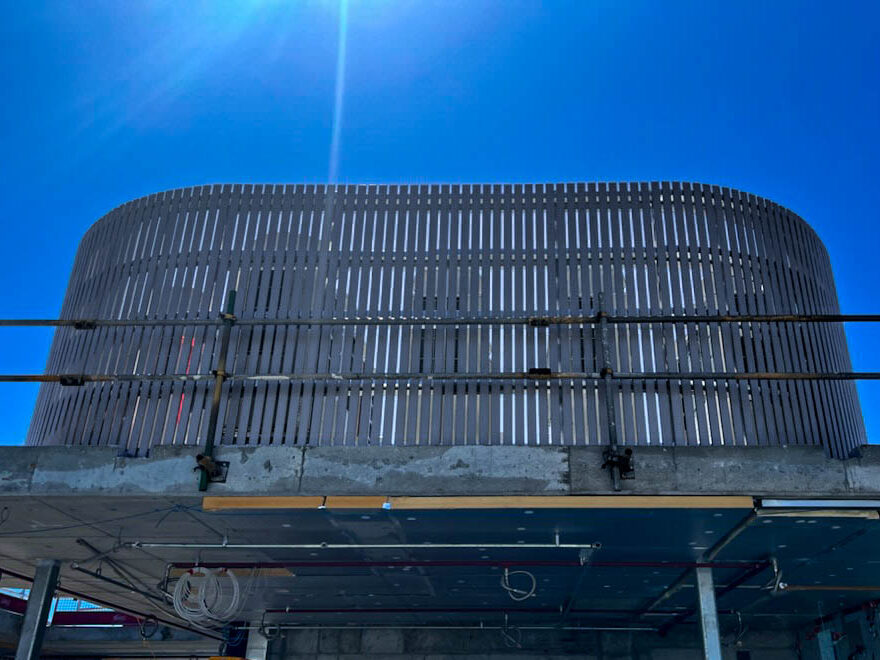-
Australia
Copyright © 2025 Powered by BCI Media Group Pty Ltd
Confirm Submission
Are you sure want to adding all Products to your Library?
Contact Detail

Would you like your next building to stand out even more when you gaze upon the city skyline?
Your rooftop space can be part of your ‘canvas’ when you collaborate with Con-form Group, the market leader in platform-screen-access systems for HVAC&R equipment for over 20 years.
Whether you would like flowing curves, unusual angles, cut-outs, diagonals, height variations, contemporary colours or more…anything is possible.
Take advantage of our Digital Design Centre, Product Development Centre and Manufacturing Centre of Excellence to engineer and produce a bespoke screen solution which complements your design theme.
A marriage of beautiful aesthetics with functionality.
Angled Approach
Rather than opt for a conventional vertical screen, this architect specified a louvre wall tilted back at 75 degrees.
It is an industry-first and was interpreted mechanically by our engineering and production teams who produced the three dimensional CAD file then built a section of it as a life-size prototype to prove the digital design.
The LouvreWall enclosure measures 42.5 metres x 10.5 metres and contains more than 600 louvre blades. They are finished in an attractive Monument colour which complements the building design.
From a practical point of view the louvres are a visual barrier and hide the HVAC&R machinery and ducting from view whilst allowing 55% airflow through to the equipment to maximise operation.
Creative Curves

The architect called for a curved screen which had three purposes: to obscure the HVAC&R plant machinery from view, reduce outbound noise generated by the equipment and creatively complement the rounded theme of the building.
Two types of screens were selected: Acoustic+, an acoustic barrier, for the ‘noisy side’ and a visual barrier, ClassicScreenWall, for the other. The frame had to be attached directly to the concrete roof. Con-form Group has solutions for both concrete and metal roofs.
Not only was this a different shape (our first curved corner project!), it had to be 2400mm high which called for a specific frame to be made to brace it against increased wind turbulence, and instead of the panels being mounted horizontally as is standard, they were to be attached vertically.
Due to Con-form Group being a seamless design-to-installation (D2i) facility we were able to involve our industrial designers, structural and mechanical engineers, CAD modellers and production team. They collaborated on the 3D CAD/CAM concept and physical prototype which was constructed in our Manufacturing Centre of Excellence. A detailed shop drawing based on the actual site conditions played a major role in the approval process as well as fabrication. An attractive colour, Copper Metallic Kinetic by Dulux, was selected for the exterior surface.
Con-form Group is proud to have contributed to the Perth skyline!
Why Are Acoustics So Important To Your Design?
Con-form Group has witnessed too many building companies experience budget blowouts because they have failed acoustic audits at the completion of their projects. There was no consideration about the amount of noise that HVAC&R mechanical equipment produces.
Instead of specifying appropriate noise control barriers at the design phase, the companies were forced to add a solution after the roof space had been occupied by the usual array of structures and services….at greater cost than if it had been pre-arranged. This situation often causes challenges for companies such as Con-form Group because we have very little room in which to install our screen systems. Fortunately, our engineers are able to customise solutions to suit each individual roof space.
The smart approach is to include us in the initial stages of the project. We can advise as to the best fit-for-purpose approach which can be costed in from the outset.
HVAC&R systems produce different levels of noise, often in different directions at the same time, and our engineers know how to identify the correct solution for your next project – the required NRC rating, size and thickness of the absorptive material and metal screen, where to locate it and how it will be fastened to the roof.
No nasty surprises at the end.



